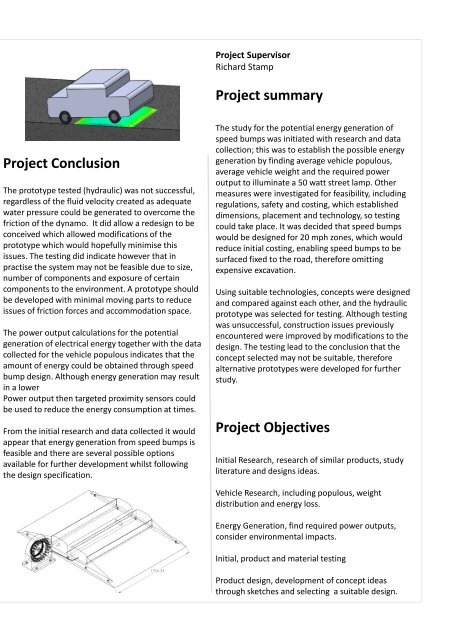UWE Bristol Engineering showcase 2015
You also want an ePaper? Increase the reach of your titles
YUMPU automatically turns print PDFs into web optimized ePapers that Google loves.
Timothy Stone<br />
Mechanical <strong>Engineering</strong> (Meng)<br />
Project Supervisor<br />
Richard Stamp<br />
Project summary<br />
Speed Bump Design for Energy Collection<br />
Concept Prototyping<br />
Upon setting up the system it quickly became<br />
apparent that generating energy was not possible.<br />
When applying any load whilst keeping the plastic<br />
tubing level, water came out and span the wheel,<br />
however, when connecting the dynamo, the wheel<br />
was unable to overcome the frictional forces as<br />
Figure 35 demonstrates. Even when using a garden<br />
hose at mains pressure, the velocity of the water<br />
was still inadequate and unable to move the wheel<br />
when the dynamo was attached. Although this test<br />
could be seen to have failed, the wheel was able<br />
to move very quickly when the dynamo was not<br />
attached, which proves the force was able to<br />
convert into rotational velocity, if the wheel could<br />
overcome the friction then this experiment would<br />
have generated results. To confirm the friction<br />
could not overcome different shaft diameters,<br />
fluid storage and tubing were all tested without<br />
providing results.<br />
Material Selection<br />
A static simulation was complete with permanent<br />
fixings, to stop movement or rotation. The speed<br />
bump was also secured to stop movement in the<br />
normal direction; so it would act as if on a road of<br />
no compressibility. The pressure was assumed to<br />
act either across the surface area of the car tyre or<br />
evenly distributed across each side, dependent on<br />
how the force acts, or the size of the vehicle being<br />
tested. This was to give the maximum stress<br />
possible throughout simulations.<br />
Project Conclusion<br />
The prototype tested (hydraulic) was not successful,<br />
regardless of the fluid velocity created as adequate<br />
water pressure could be generated to overcome the<br />
friction of the dynamo. It did allow a redesign to be<br />
conceived which allowed modifications of the<br />
prototype which would hopefully minimise this<br />
issues. The testing did indicate however that in<br />
practise the system may not be feasible due to size,<br />
number of components and exposure of certain<br />
components to the environment. A prototype should<br />
be developed with minimal moving parts to reduce<br />
issues of friction forces and accommodation space.<br />
The power output calculations for the potential<br />
generation of electrical energy together with the data<br />
collected for the vehicle populous indicates that the<br />
amount of energy could be obtained through speed<br />
bump design. Although energy generation may result<br />
in a lower<br />
Power output then targeted proximity sensors could<br />
be used to reduce the energy consumption at times.<br />
The study for the potential energy generation of<br />
speed bumps was initiated with research and data<br />
collection; this was to establish the possible energy<br />
generation by finding average vehicle populous,<br />
average vehicle weight and the required power<br />
output to illuminate a 50 watt street lamp. Other<br />
measures were investigated for feasibility, including<br />
regulations, safety and costing, which established<br />
dimensions, placement and technology, so testing<br />
could take place. It was decided that speed bumps<br />
would be designed for 20 mph zones, which would<br />
reduce initial costing, enabling speed bumps to be<br />
surfaced fixed to the road, therefore omitting<br />
expensive excavation.<br />
Using suitable technologies, concepts were designed<br />
and compared against each other, and the hydraulic<br />
prototype was selected for testing. Although testing<br />
was unsuccessful, construction issues previously<br />
encountered were improved by modifications to the<br />
design. The testing lead to the conclusion that the<br />
concept selected may not be suitable, therefore<br />
alternative prototypes were developed for further<br />
study.<br />
From observing the four different simulations, the<br />
highest stress level was selected, so the material<br />
would have to withstand a yield stress of 8.5MPa.<br />
If a factor of safety of three is to be used, the<br />
actual value for yield stress required is 25.5MPa.<br />
From the initial research and data collected it would<br />
appear that energy generation from speed bumps is<br />
feasible and there are several possible options<br />
available for further development whilst following<br />
the design specification.<br />
Project Objectives<br />
Initial Research, research of similar products, study<br />
literature and designs ideas.<br />
A potential solution to solving this issue is to<br />
reduce the friction by either creating a gearing<br />
relationship between the dynamo and the wheel<br />
or by designing a solid shaft which holds the<br />
water wheel and the rotational shaft of the<br />
dynamo.<br />
To find the most suitable material, a program<br />
known as Cambridge <strong>Engineering</strong> Selector was<br />
used. By setting the minimum properties as<br />
discussed and setting each material.<br />
Fibreboard is suitable, as it can be easily made<br />
weatherproof and the majority are produced from<br />
sustainably grown timber, which is abundant in the<br />
United Kingdom, and are also produced from parts<br />
of a tree which have no other use<br />
Vehicle Research, including populous, weight<br />
distribution and energy loss.<br />
Energy Generation, find required power outputs,<br />
consider environmental impacts.<br />
Initial, product and material testing<br />
Product design, development of concept ideas<br />
through sketches and selecting a suitable design.


